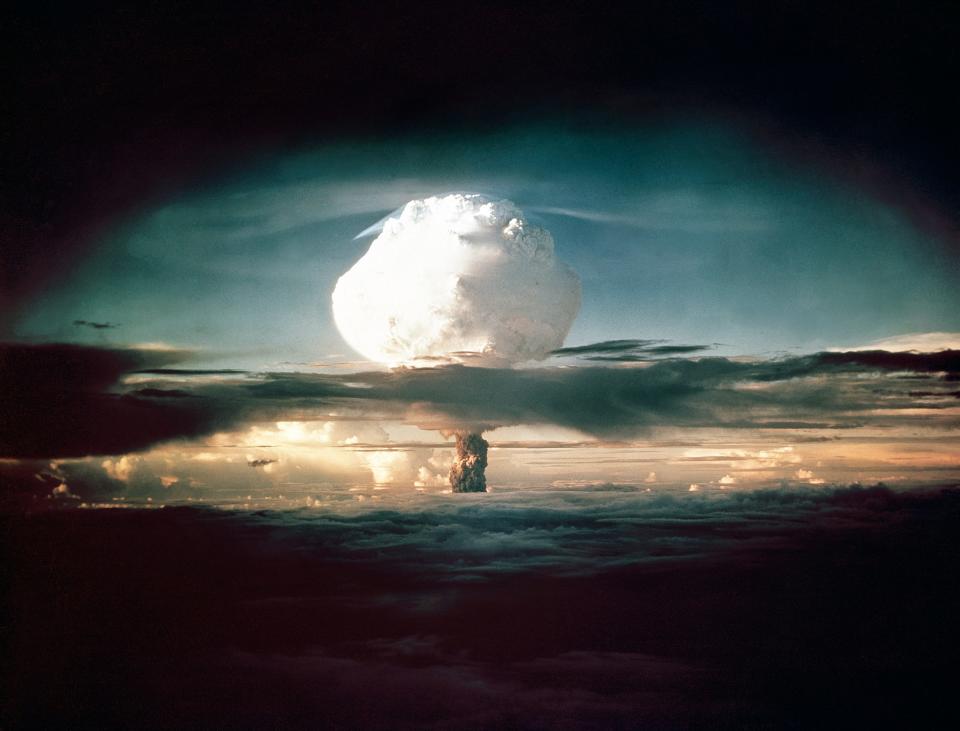2023 Doomsday Clock announcement on Tuesday could warn of nuclear war
- Oops!Something went wrong.Please try again later.
Follow USA TODAY's live coverage of Doomsday Clock announcement on Tuesday.
Each year for the past 75 years, the Bulletin of the Atomic Scientists has published a new Doomsday Clock, suggesting just how close – or far – humanity is from the brink.
The next edition will be revealed Tuesday, Jan. 24 at 10 a.m. EST. It's the first update to the clock since Russia's invasion of Ukraine renewed fears of global nuclear war.
Historically, the clock has measured the danger of nuclear disaster, but that's not the only apocalyptic scenario being considered. Climate change, bioterrorism, artificial intelligence and the damage done by mis- and disinformation also have been included in the mix of possible cataclysms.
STUDY: Nuclear war between US, Russia would leave 5 billion dead from hunger
QUESTIONS: What country has the most nuclear weapons? Can the US stop a nuclear attack?
Each year, the 22 members of the Science and Security Board are asked two questions:
Is humanity safer or at greater risk this year than last year?
Is humanity safer or at greater risk compared to the 76 years the clock has been set?
Here's what to know about the 2023 Doomsday Clock:
How did the Doomsday Clock start?
In 1945, on the anniversary of the bombing of Pearl Harbor, scientists who had worked on the Manhattan Project that built the world's first atomic bombs began publishing a mimeographed newsletter called The Bulletin of the Atomic Scientists.
Two years later, as those same scientists contemplated a world in which two atomic weapons had been used in Japan, they gathered to discuss the threat to humanity posed by nuclear war.
"They were worried the public wasn't really aware of how close we were to the end of life as we knew it," said Rachel Bronson, president and CEO of the Bulletin.
Martyl Langsdorf, an artist and wife of Manhattan project physicist Alexander Langsdorf Jr., came up with the idea of a clock showing just how close things were.
It came to be called the Doomsday Clock.
"It gave the sense that if we did nothing, it would tick on toward midnight and we could experience the apocalypse," Bronson said.

Where does the Doomsday Clock stand now?
For the past two years the Doomsday Clock has stood at 100 seconds to midnight, closer to destruction than at any point since it was created in 1947.
What does midnight represent on the Doomsday Clock?
Midnight on the Doomsday Clock represents how close humans are to bringing about civilization-ending catastrophe because of the unleashing of human-caused perils either by nuclear disaster, climate change or other cataclysms.
Who decides where the Doomsday Clock is set?
The Doomsday Clock is set each year by the 22 members of the Bulletin's Science and Security Board in consultation with its Board of Sponsors, which includes 11 Nobel laureates.

Why does the Doomsday Clock exist?
At its heart, the bulletin's founders were asking how well humanity was managing the "dangerous Pandora's box made possible by modern science," Bronson said.
Though technology makes possible amazing and wonderful things, it can also pose risks. In 1947 the biggest of those was nuclear war. Since then the bulletin has added others, including climate change, bioterrorism, artificial intelligence and the damage done by mis- and disinformation.
Why is the Doomsday Clock so prominent?
Over the years the clock has been referenced by the White House, the Kremlin and the leadership of many other nations. Robert Oppenheimer and Albert Einstein were on the bulletin's Board of Sponsors, and John F. Kennedy and Richard Nixon wrote pieces for the magazine.
Though not everyone agrees with the clock's settings, it is generally respected for the questions it asks and for its science-based stance.
Does the Doomsday Clock always go forward?
The setting of the clock has jumped forward and back over the past 75 years, depending on world events.
The furthest from midnight it has ever been was in 1991, when it was set at 17 minutes to midnight after the U.S. and the Soviet Union signed the first Strategic Arms Reduction Treaty, followed by the dissolution of the USSR.
"People would go to sleep every night worried about were they going to wake up," said Daniel Holz, a professor of physics at the University of Chicago and co-chair of the Bulletin's Science and Security Board. "That threat was definitely reduced at the end of the Cold War."
The most pessimistic years have been 2021 and 2022, when it was set at 100 seconds to midnight, in part because of global nuclear and political tensions, COVID-19, climate change and the threat of biological weapons.
The first clock, announced in 1947, was set at 7 minutes to midnight.
What will the Doomsday Clock be set to on Jan. 24, 2023?
The Doomsday Clock will be reset Jan. 24 at 10 a.m. EST in an announcement that will be livestreamed on the bulletin's website.
Exactly what time the scientists who make up the board have chosen is a closely held secret. But one hint is this: For the first time, the statement is being translated into Russian and Ukrainian.
This article originally appeared on USA TODAY: 2023 Doomsday Clock announcement Tuesday to warn of nuclear war
